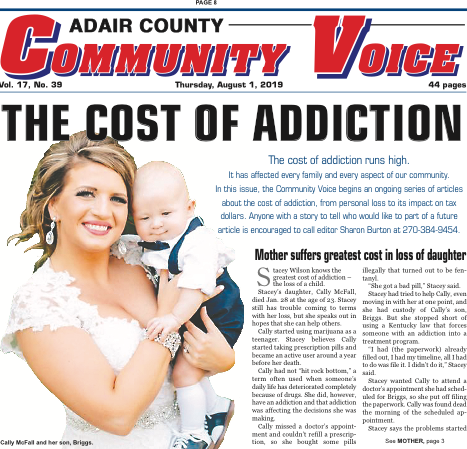“She is hard-nosed and soft-hearted,” Al Cross, the Director of the Institute for Rural Journalism and Community Issues told Poynter. Cross is a professor, a lifelong Kentucky journalist and an advocate for rural journalism. Poynter heard about The Adair Community Voice’s reporting on opioids from Cross’s widely regarded Rural Blog. Cross said that in his more than 40 years of Kentucky journalism experience, he has never seen anything like the work that Burton is doing for her community.
“Weeklies don’t like to cover this topic — it reflects poorly on the community,” Cross explained. “When they cover stuff like this it is only from a criminal justice point of view. It is a health story. It’s a community well-being story. It is the kind of thing communities ought to work together to solve.”
Cross said that when news organizations only cover addictions when a case comes to court, it stigmatizes the issue.
“Community newspapers need to step up … to bring awareness to the problems, not sweep them under the rug,” he said.
Burton agreed.
“This is the elephant in the room. It is here and it is something we have to, we will discuss,” she said. “For people who are thinking, ‘Hey, you are writing a bunch of negative stuff about our town,’ I say it is because we love our town.”
Burton said the notion that small-town advertisers won’t buy ads in a newspaper that covers controversy isn’t true. “We do real news because people want real news,” she said.
She said a local doctor wrote a guest column last week giving a physician’s point of view.
“I think she felt I was being too critical of the medical community’s involvement in the opioid story. I am critical of the medical community and I am also glad to include that doctor’s point of view,” Burton said. But, “We have gotten more positive reaction to this than anything we have done in a long time, maybe since I suggested in an editorial that we needed less government and should consolidate city and county governments. That drew some reaction alright.”
Burton writes about 80 percent of the news content for the paper each week. In December, she explored her county’s needle exchange program, which has drawn “a fair amount of criticism,” she said. It’s the stunning details of what the exchange program has learned that helped her and her readers understand the depth of the crisis.
“Of 1,135 clients in the district who self-reported, a total of 420 needle exchange participants (37%) reported injecting drugs at least nine times a daily. Another 339 reported using six to eight times daily and 270 reported using at least three to five times daily. A total of 317 clients reported testing positive for hepatitis C,” which is prevalent among IV drug users.
Last week, Burton asked the needle exchange program to allow her to walk in and ask for needles and to participate in the conversations that a person with an addiction would undergo.
“I wanted to know what it would feel like just to ask for needles so I would know what it feels like to say you want a product to use because you are addicted and need to stick needles in your arm.”
